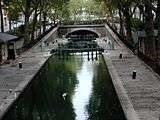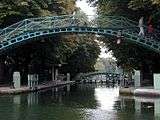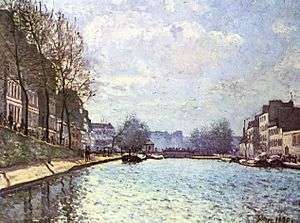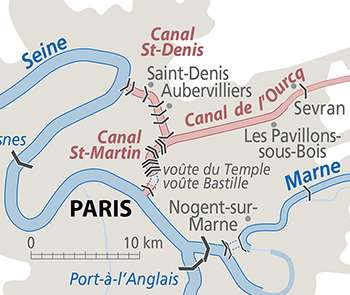Canal Saint-Martin
| Canal Saint-Martin | |
|---|---|
|
Location of the three Paris canals (zooming on the Saint-Martin and Saint-Denis), from the Inland Waterways of France map by David Edwards-May, publ. Imray, 2012 | |
| Specifications | |
| Length | 4.6 km |
| Maximum boat length | 40.70 m (133.5 ft) |
| Maximum boat beam | 7.70 m (25.3 ft) |
| Locks | 9 |
| History | |
| Current owner | Ville de Paris |
| Date approved | 1802 |
| Date completed | 1825 |
| Geography | |
| Start point | Paris Place de Stalingrad (Bassin de la Villette, Canal de l'Ourcq) |
| End point | Paris Quai de la Râpée (entrance lock from Seine) |
| Connects to | Seine, Canal de l'Ourcq |
The Canal Saint-Martin is a 4.5 km long canal in Paris, connecting the Canal de l'Ourcq to the river Seine. Over nearly half its length (2069 m), between the Rue du Faubourg du Temple and the Place de la Bastille, it was covered in the mid-19th century to create wide boulvards and public spaces on the surface[1]. The canal is drained and cleaned every 10-15 years, and it is always a source of fascination for Parisians to discover curiosities and even some treasures among the hundreds of tonnes of discarded objects.
History

Construction of the canal was ordered by Napoleon I in 1802, in order to create an artificial waterway for supplying Paris with fresh water. The water diverted from the river Ourcq would support a growing population and help avoid diseases such as dysentery and cholera, also supplying fountains and allowing the streets to be cleaned.
Gaspard de Chabrol, prefect of Paris, proposed building a canal from the Ourcq River (starting 100 km northeast of Paris). The canal was dug from 1802 to 1825, funded by a new tax on wine. The canal was also used to supply Paris with food (grain), building materials, and other goods, carried on canal boats. Two ports were created in Paris on the canal to unload the boats: the Port de l'Arsenal and the Bassin de la Villette.
By the 1960s, traffic had dwindled to a trickle and the canal narrowly escaped being filled in and paved over for a highway.
En route
The entrance to the canal from the vast terminal basin (Bassin de la Villette) of the Canal de l'Ourcq is at a double lock near the Place de Stalingrad. Continuing towards the river Seine, the canal is bordered by the Quai de Valmy on the right bank and the Quai de Jemmapes on the left, passing through three more double staircase locks before disappearing under the three successive voûtes or tunnels – du Temple, Richard-Lenoir and Bastille – to emerge in the Port de l'Arsenal, the principal port for boats visiting and residing in Paris.
 At the southern end of the canal; locks and northern portal of the tunnel
At the southern end of the canal; locks and northern portal of the tunnel- The Boulevard Jules-Ferry, which covers the lower end of the canal
 A typical iron bridge over the canal
A typical iron bridge over the canal The locks of the Récollets
The locks of the Récollets Afghan refugees, living under a bridge
Afghan refugees, living under a bridge
Tourism
Today, the canal is a popular destination for Parisians and tourists. Some take cruises on the canal in passenger boats. Others watch the barges and other boats navigate the series of locks and pass under the attractive cast-iron footbridges. There are many popular restaurants and bars along the open part of the canal, which is also popular with students.
Métro Stations
The canal can be accessed from the following Paris Métro stations: Stalingrad, République, Goncourt, Jaurès, Oberkampf, Richard-Lenoir, Bastille, and Quai de la Rapée.
Canal Saint-Martin in culture
Art

The canal inspired painters such as Alfred Sisley (1839-1899). In the present day, many intricate works of graffiti are visible along the canal, and there is a large multimedia art space on its banks at the former municipal undertakers building at 104 rue d'Aubervilliers ('104').
Appearances in film and television
- The canal is shown in the 1938 film Hôtel du Nord, directed by Marcel Carné.[2]
- The canal was also the setting in part for Jean Vigo's film L'Atalante in 1934.
- In Les Malheurs d'Alfred (1972), Pierre Richard and Anny Duperey meet each other at the beginning of the film, thinking of committing suicide in the canal.
- The canal appears in Jean-Pierre Jeunet's famous 2001 film known in English as Amélie, in which the title character is shown enjoying one of her favourite activities: skipping stones at the locks of the canal.
Music
- Édith Piaf sings about the canal in the song "Les mômes de la cloche", written by Vincent Scotto and Decaye, music by Médinger, in 1936.
Notes
- ↑ Edwards-May, David (2010). Inland Waterways of France. St Ives, Cambs., UK: Imray. pp. 90–94. ISBN 978-1-846230-14-1.
- ↑ However, the film was shot in the studios of Boulogne-Billancourt where the scenery of the canal was rebuilt by Alexandre Trauner.
External links
- Paris - Canal de l'Ourcq, Canal Saint-Denis and Canal Saint-Martin maps and information on places, ports and moorings on the canals, by the author of Inland Waterways of France, Imray
- Navigation details for 80 French rivers and canals (French waterways website section)
- Blog of the Canal Saint-Martin quarter (in French)
- Canal Saint-Martin map (in French)
- The sunken treasures of a Paris canal
